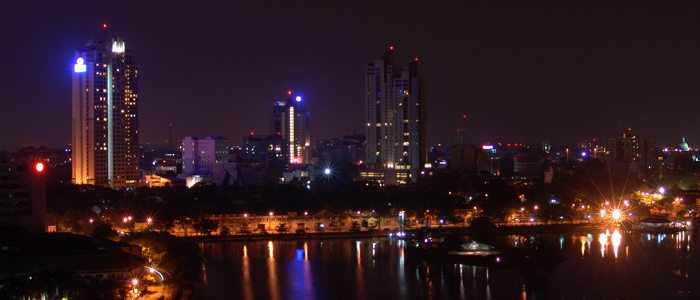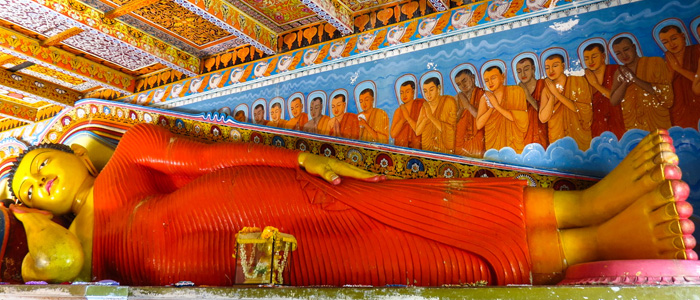Day 1 Airport/ Colombo
On arrival at the Colombo International Airport you will be warmly welcomed by our representative, introduce your guide lecture and begin proceed to Colombo the commercial capital in Sri Lanka. You will drive through the commercial area of Fort, so named because both the Portuguese and Dutch had a fort at this point. Drive past Pettah, a noisy Oriental bazaar with a mix of humanity, ancient vehicles, bargains, mosques and temples. You will visit a Hindu and Buddhist Temple and the Jumi Ul Alfar Jumma Mosque. You will continue with the tour through the Wolfendhal Dutch Church, Hulftsdorp Law Courts, through the residential area of Cinnamon Gardens, and on to the Independence Square, Bandaranayke Memorial International Conference Hall.
There is plenty of nightlife in Colombo. Many casinos, or otherwise also called clubs here, scream for your attention with flashing neon lights. The clubs offer gamblers roulette, baccarat, poker, blackjack, and other games to try their luck as well as complimentary food and drinks, and sometimes music with live bands playing. Entrance is only for those over 18 years and some clubs offer entrance only for foreigners. Be dressed in smart casual for instant admission.
Furthermore, from chic relaxing cocktail lounges, and modern international restaurants to lively pubs, tapas bars and sports bars boasting snooker tables and large-screen TV’s, there’s something for everyone. With ever-popular karaoke bars, nightclubs showcasing new musical talent, and pulsating discos - the choice is endless.
You're overnight staying at Colombo.

Day 2 Anuradhapura/Yapahuwa
We will departure early from the hotel to Anuradhapura. Breakfast get on your way. We can visit Yapahuwa en-route.
Yapahuwa was the capital of ancient Lanka for a brief period from 1273 to 1284. It was built in the style of Sigiriya and stands resplendently above a 90 meters height rock. Yapahuwa was a royal palace and a military fortress, originally constructed by King Buvanekabahu in 1273. As with many ancient sites in Sri Lanka, Yapahuwa was later used as a Buddhist monastery and its history and significance are entwined in a web of monarchistic and religious influences from different periods of Sri Lankan history. Indeed, Yapahuwa was also used to house the sacred tooth relic for a period – Sri Lanka’s most treasured Buddhist relic. There are a number of caves at the base of the rock with some interesting shrines, moats and ramparts.
Sri Lanka’s first capital, Anuradhapura, located within the Cultural Triangle in the North central province, was the greatest monastic city of the ancient world. It was royal capital for more than 100 Sri Lankan kings and at its heights was home to thousands of monks from dozens of monasteries. Originally founded by a minister called Anuradha, in the 4th century BC, it became the capital of Sri Lanka two centuries later. After a long and sometimes bloody history, it was abandoned in 1073 and is now today the most important religious and cultural site in Sri Lanka. The ruins of Mahavihara, the first Monastery, which served as the seat of Theravada Buddhism, as well as the Thuparamaya, built by King Devanam Piyatissa in 250 B.C.E, the Ruwanwelisaya, and several other monasteries and temples can be seen. The ancient Bo Tree, which was originally a branch of the Bo tree in Buddha Gaya under which Lord Buddha attained enlightenment and brought to Sri Lanka by Emperor Asoka’s daughter, Princess Sangamiita, also is in Anuradhapura.
There are uncountable scenic places in Anuradhapura. We visit the main places as Ruwanweli stupa, Jayasri ma bodhi, Mirisawetiya, Tisawewa (Lake), Isurumuniya, Samadhi statue, Lowamahapaya.
You're overnight staying at Anuradhapura hotel.

Day 3 Anuradhapura
Breakfast at hotel and we continue the visit surrounding Anuradhapura.
You're overnight staying at Anuradhapura.
Day 4 Anuradhapura/Polonnaruwa
After breakfast we begin our journey to Polonnaruwa. Polonnaruwa was the capital of the second civilization to establish itself in ancient Lanka after Anuradhapura. It was the seat of the Sinhala Kingdom between the middle of the 11th century to the 13th century.
Grew out of the arid plains of the north central province, the kingdom in Polonnaruwa depended heavily on channeled water to irrigate its fields. This demanded the construction of massive irrigation projects. Although the civilization in Sri Lanka is not as popular, their engineering feat rivals those of Angkor, Egypt and ancient China.
There are uncountable scenic places with ruins. World most popular places are,
ParakarmaSamudra:
ParakarmaSamudra is a manmade irrigation tank spread over an area of 5940 acres, built by the King Parakramabahu.
Royal Citadel:
The Citadel housed the palace and the administrative buildings of King Prakramabahu who ruled in12th century AD and is enclosed by a huge rampart more than a meter thick.
Gal Vihara:
It is a rock cut Buddhist shrine dating back to 12th century AD. It contains magnificent images of Buddha carved out of stone.
Vata-Da-Ge:
A circular relic chamber built enclosing a pagoda that had been a popular architectural style in ancient Sri Lanka.
Hatadage:
A relic chamber built by King Parakramabahu I to house the sacred Tooth Relic.
Lotus Pond:
A stone pond built in the shape of a lotus flower in eight parallel tiers probably to provide seating to the monks while bathing.
You're overnight staying at Polonnaruwa.

Day 5 Polonnaruwa/ Dambulla
After the breakfast we proceed to the Dambulla through the coconut plantations. The name Dambulla derives from Damba – Rock and Ulla – fountain. One sees the incessant drip of water from the fountain within the main image house .This rock cave temple is must for any tourist who visits Sri Lanka. In history, Dambulla back dates to the 1st century BC. It has five caves under a vast overhanging rock, carved with a drip line to keep the interiors dry. The Dambulla cave monastery is still functional and remains the best-preserved ancient edifice in Sri Lanka.
(Optional: Sigiriya Rising 200 meters vertically from the flat pains, Sigiriya Rock provides you with one of the most dramatic sites in Sri Lanka. Top of this rock contains ruins of an ancient palace complex, built during the reign of King Kashyapa (477AD – 495AD) and surrounding rock is the Royal Garden. It is one of the 7 world heritage sites in Sri Lanka and is one of its most popular tourist destinations. The Sigiriya site consists of a 200 meter tall granite rock, whose sides are so steep that at some points the top overhangs the base. Ruins of various chambers, stairways and pools can be seen at the top of this rock. There is a stone stairway leading from the base to the top of the mountain. About half way to the top, there is a giant pair of lions paws which is in fact are the remains of a huge head of a lion whose open mouth served as the entrance to the royal palace. Surrounding the palace complex are the ruins of a garden complex consisting of two moats and various pools, some with water fountains still functioning after 1500 years. Sigiriya is world famous for its frescoes. It is believed that there were paintings all over the rock which were later destroyed, only 22 still remaining. The frescoes are the only non-religious old painting in Sri Lanka.)
You're overnight staying at Dambulla.

Day 6 Dambulla/Kandy
After the breakfast at hotel and we proceed to Kandy. We can visit Aluvihara cave temple, Nalanda gedige and Muththumari Amman Hindu temple en-route. The history of Aluvihara is traced back to the 3rd Century B.C. in the reign of King Devanampiyatissa.
There is an unidentified statue found in Nalanda gedige by archaeology department of Sri Lanka and according to the appearance it has no similarity with a human being but it shows more similarities to an extra terrestrial being. The survey department of Sri Lanka has proved that this location is exactly the middle of the island.
Then we reached to Kandy, the last royal capital of Sri Lanka is a major tourist destination. The city established in the 15th century was the last royal capital where 2500 years of royal rule ended. (465 meters above mean sea level). Famous for the Temple of the Tooth relic and many other temples the city could be called the cultural capital of the island. Kandy Perahera, the pageant of the temple of tooth relic is held either in July or August each year. Must see if one visit Sri Lanka during these months. The final night procession is the most spectacular event of the country. More than 50 elephants parade the city accompanied by the drummers, dancers and chieftains.
We visit temple of tooth relic, Kandy city tour, Evening enjoy a typical Sri Lankan Cultural show of drumming dancing music and walking on fire.
You're overnight staying at Kandy.

Day 7 Kandy/Negombo
After the breakfast at hotel, we proceed to Negombo and we can visit Pinnawala elephant orphanage or Pinnawala open Air zoo en-route.
Pinnawala is the most popular and accessible place to see large numbers of these lovable animals in a natural habitat. It is the most popular elephant ‘attraction’ with tourists because nowhere else, the orphanage was originally founded in order to afford care and protection to the many orphaned Elephants found in the jungle. The main attraction is clearly observe the feeding milk by bottle and bathing elephants from the tall river bank, as well as it allows visitors to observe the herd interacting socially, bathing and playing.
(Optional: Pinnawala open Air zoo. This is the first open air zoo in the Sri Lanka. The Pinnawala zoo is home for the many endemic animals in Sri Lanka. The zoo is divided into two sections: the Sri Lankan zone and the World zone. Currently, the zoo is home for many native animals such as chital, Sri Lanka leopard, Purple-faced leaf monkey, Wild boar, Sambar, Asian elephant, and different endemic bird species. The leopard watching area is the largest of all.)
Negombo is a Dutch captured the town from the Portuguese in 1640. It is referred as “little Rome”. The town is dotted with shrines and churches as a majority of Negombo population is Roman Catholic. St. Mary’s church, built in 1874 the biggest of them all is worthy of a visit. Negombo fish market, Dutch fort, Dutch canal are the other highlighted places to visit.
Dutch canal boat tour or Muthurajawela marsh boat safari are depend on time.
You're overnight staying at Negombo

Day 8 Negombo/Airport
After breakfast leave to the Airport for your departure. (Depend on your flight schedule leisure at the Negombo beach)
This itinerary can be tailored to your specific requirements, budget and tastes.
* Prices are quoted for one person on twin sharing basis.














